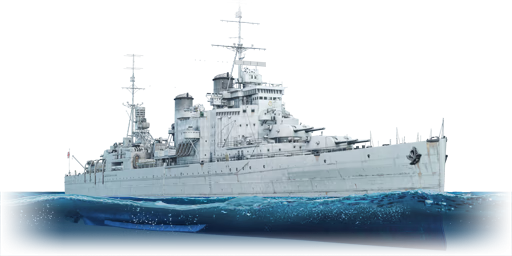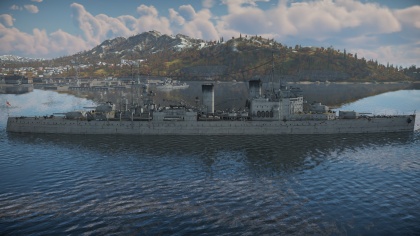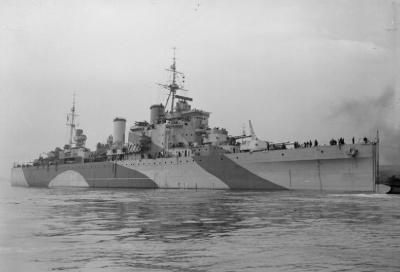Difference between revisions of "HMS London"
Bonisducks (talk | contribs) (→History) (Tag: Visual edit) |
Bonisducks (talk | contribs) (→External links: Done History and References.) (Tag: Visual edit) |
||
| Line 90: | Line 90: | ||
=== Design and construction === | === Design and construction === | ||
| − | The ''London'', similar to her predecessors, was designed as a treaty cruiser of the Washington Naval Treaty. Thus, she was built within the 10-thousand ton standard-displacement limit and suffered, subsequently, from having little armour. She carried substantial armament of eight 8-inch (203 mm) guns in four double mounts, as well as two quadruple torpedo launchers.<ref name=":0"> | + | The ''London'', similar to her predecessors, was designed as a treaty cruiser of the Washington Naval Treaty. Thus, she was built within the 10-thousand ton standard-displacement limit and suffered, subsequently, from having little armour. She carried substantial armament of eight 8-inch (203 mm) guns in four double mounts, as well as two quadruple torpedo launchers.<ref name=":0">Chen, C. (2007)</ref> She was also one of the only County-class ships to receive an improved anti-aircraft armament. She could make a top speed of 31 knots (57 km/h).<ref name=":0" /> |
| − | The ''London'' was laid down in February of 1926, and was launched in September of 1927. She was formally commissioned on January 31st 1929.<ref name=":0" /><ref name=":1"> | + | The ''London'' was laid down in February of 1926, and was launched in September of 1927. She was formally commissioned on January 31st 1929.<ref name=":0" /><ref name=":1">Helgason, G. (1995)</ref> |
=== Operational service === | === Operational service === | ||
| Line 118: | Line 118: | ||
* [[wt:en/news/6626-development-hms-london-anticipated-calibre-en|[Devblog] HMS London: Anticipated Calibre]] | * [[wt:en/news/6626-development-hms-london-anticipated-calibre-en|[Devblog] HMS London: Anticipated Calibre]] | ||
| + | === References === | ||
| + | <references /> | ||
| + | |||
| + | === Works Cited === | ||
| + | |||
| + | * Chen, C. (2007, May). Heavy Cruiser London. Retrieved November 17, 2020, from <nowiki>https://ww2db.com/ship_spec.php?ship_id=326</nowiki> | ||
| + | * Helgason, G. (1995). HMS London (69). Retrieved November 17, 2020, from <nowiki>https://uboat.net/allies/warships/ship/1178.html</nowiki> | ||
{{Britain heavy cruisers}} | {{Britain heavy cruisers}} | ||
Revision as of 20:13, 17 November 2020
Contents
Description
The County-class, HMS London (69), 1945 is a rank IV British heavy cruiser
with a battle rating of 5.7 (AB/RB/SB). It was introduced in Update 1.97 "Viking Fury".
General info
Survivability and armour
Talk about the vehicle's armour. Note the most well-defended and most vulnerable zones, e.g. the ammo magazine. Evaluate the composition of components and assemblies responsible for movement and manoeuvrability. Evaluate the survivability of the primary and secondary armaments separately. Don't forget to mention the size of the crew, which plays an important role in fleet mechanics. Save tips on preserving survivability for the "Usage in battles" section. If necessary, use a graphical template to show the most well-protected or most vulnerable points in the armour.
Mobility
Write about the ship's mobility. Evaluate its power and manoeuvrability, rudder rerouting speed, stopping speed at full tilt, with its maximum forward and reverse speed.
Armament
Primary armament
Provide information about the characteristics of the primary armament. Evaluate their efficacy in battle based on their reload speed, ballistics and the capacity of their shells. Add a link to the main article about the weapon: {main|Weapon name (calibre)}. Broadly describe the ammunition available for the primary armament, and provide recommendations on how to use it and which ammunition to choose.
Secondary armament
Some ships are fitted with weapons of various calibres. Secondary armaments are defined as weapons chosen with the control Select secondary weapon. Evaluate the secondary armaments and give advice on how to use them. Describe the ammunition available for the secondary armament. Provide recommendations on how to use them and which ammunition to choose. Remember that any anti-air armament, even heavy calibre weapons, belong in the next section. If there is no secondary armament, remove this section.
Anti-aircraft armament
An important part of the ship's armament responsible for air defence. Anti-aircraft armament is defined by the weapon chosen with the control Select anti-aircraft weapons. Talk about the ship's anti-air cannons and machine guns, the number of guns and their positions, their effective range, and about their overall effectiveness – including against surface targets. If there are no anti-aircraft armaments, remove this section.
Torpedo armament
Torpedoes launchers are standard equipment on many ships and boats. Torpedoes are a significant means of defeating an opponent. Evaluate the position of the torpedo launchers, discuss the ammunition available, firing specifics such as dead zones, features of the torpedoes themselves, etc. If there is no torpedo armament, remove this section.
Special armament
Depth charges, mines, rocket launchers and missiles are also effective in skilled hands and can take an off-guard opponent by surprise. Evaluate the ammunition of this type of armament and rate its performance in combat. If there are no special armaments, remove this section.
Usage in battles
Describe the technique of using this ship, the characteristics of her use in a team and tips on strategy. Abstain from writing an entire guide – don't try to provide a single point of view, but give the reader food for thought. Talk about the most dangerous opponents for this vehicle and provide recommendations on fighting them. If necessary, note the specifics of playing with this vehicle in various modes (AB, RB, SB).
Modules
| Tier | Seakeeping | Unsinkability | Firepower | |||
|---|---|---|---|---|---|---|
| I | Dry-Docking | Tool Set | 8 inch Mark I.B. SAPCBC | 4 inch SAP | Anti-Air Armament Targeting | |
| II | Rudder Replacement | Fire Protection System | Smokescreen | 4 inch HE-TF | Auxiliary Armament Targeting | |
| III | Propeller Replacement | Shrapnel Protection | Ventilation | Improved Rangefinder | 4 inch HE-VT | Primary Armament Targeting |
| IV | Engine Maintenance | New Pumps | Ammo Wetting | Torpedo Mode | ||
Pros and cons
Summarise and briefly evaluate the vehicle in terms of its characteristics and combat effectiveness. Mark its pros and cons in the bulleted list. Try not to use more than 6 points for each of the characteristics. Avoid using categorical definitions such as "bad", "good" and the like - use substitutions with softer forms such as "inadequate" and "effective".
Pros:
Cons:
History
The HMS London (69) was a second-generation County-class heavy cruiser. Unlike her predecessor, HMS Kent, the London has a revised superstructure and different armour protection. Commissioned in 1929, she saw extensive service before the War including the evacuation of refugees from Barcelona, during the Spanish civil war. She was the only County-class heavy cruiser to be reconstructed, and featured a superstructure similar to the Crown Colony-class cruisers. During the Second World War, she participated in the hunt for Bismarck but spent most of her time serving with the Eastern fleet. She served with the China Station after the end of the war, and was scrapped in 1950.
Design and construction
The London, similar to her predecessors, was designed as a treaty cruiser of the Washington Naval Treaty. Thus, she was built within the 10-thousand ton standard-displacement limit and suffered, subsequently, from having little armour. She carried substantial armament of eight 8-inch (203 mm) guns in four double mounts, as well as two quadruple torpedo launchers.[1] She was also one of the only County-class ships to receive an improved anti-aircraft armament. She could make a top speed of 31 knots (57 km/h).[1]
The London was laid down in February of 1926, and was launched in September of 1927. She was formally commissioned on January 31st 1929.[1][2]
Operational service
After her commissioning, the London became the flagship of the 1st Cruiser squadron. She served with the 1st Cruiser squadron until the outbreak of war in 1939. During the Spanish civil war, London evacuated thousands of civilians from Barcelona with her sister ship Shropshire. From March 1939, she was given a lengthy refit; though her engines were not refitted, she was given a new superstructure giving her a similar appearance to the Crown Colony-class cruisers.[2]
London’s reconstruction was completed by March of 1941; she then participated in the hunt for the German battleship Bismarck.[1] During this time, it was found that her new superstructure caused significant weight stress to the upper hull, so she was repaired once again between late 1941 and early 1942.[2] When service with the British Atlantic fleet caused cracks to appear in the hull, she was repaired once again; this time, she would not be operational until 1943. Following the completion of repairs, she served with the Eastern fleet until the end of the war.[2]
As the only modernised County-class heavy cruiser, the London was selected to serve after the war. She sailed to the far east in 1946 to serve with the China Station. She remained in Chinese waters until 1949, when she was relieved by the Cruiser HMS Kenya.[2] It was determined that London’s ageing equipment and large crew complement made an additional refit unfeasible; as a result, she was sold for scrapping in 1950.[2]
Media
Excellent additions to the article would be video guides, screenshots from the game, and photos.
See also
Links to articles on the War Thunder Wiki that you think will be useful for the reader, for example:
- reference to the series of the ship;
- links to approximate analogues of other nations and research trees.
External links
References
Works Cited
- Chen, C. (2007, May). Heavy Cruiser London. Retrieved November 17, 2020, from https://ww2db.com/ship_spec.php?ship_id=326
- Helgason, G. (1995). HMS London (69). Retrieved November 17, 2020, from https://uboat.net/allies/warships/ship/1178.html
| Britain heavy cruisers | |
|---|---|
| Hawkins-class | HMS Hawkins |
| York-class | HMS York |
| County-class | HMS Kent · HMS London · HMS Norfolk |






